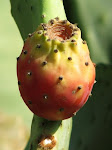We reached Nevatim agricultural settlement at noon. After passing a big, brown sign with the name 'moshav Nevatim' in hebrew (see the header), and a traditional well in memory of the founders, we were led by Mira, the local guide, to the building which houses a compact museum with some very interesting exhibits.
traditional well in memory of the founders
entrance to building housing the museum
After a few introductory words, Mira, the guide, wanted us to watch a 16-minute documentary on the history and customs of her community and its immigration to Israel. Very captivating film as it included interviews with people who were among the first settlers of Nevatim, in 1954.
Mira - her back to screen, face to visitors
The walls at the entrance and in the movie room were covered with black&white pictures depicting snippets from the community's life in India. (It is important to mention that they've had good relations with their non-jewish neighbors there ; no hostility/persecution experience whatsoever).
Merchants in Cochin, they became farmers in Nevatim - not an easy transition, that from trade to agriculture. Apparently, the shy and modest indian community underwent this transition quite well. They also got this small tourist attraction enterprise - the Heritage Center which includes the museum and the synagogue.
listening to lecture; pictures with life snippets on the walls
more Cochin life snippets on the wall
Merchants in Cochin, they became farmers in Nevatim - not an easy transition, that from trade to agriculture. Apparently, the shy and modest indian community underwent this transition quite well. They also got this small tourist attraction enterprise - the Heritage Center which includes the museum and the synagogue.
Next - open rooms with a rich variety of encased exhibits from daily life in Cochin: clothing (daily and holiday), jewelery items, household ware, religious and cultural artifacts (light holders, holiday lamps, Torah case) etc.





















































